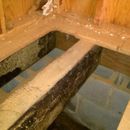Creosote-Treated Floor Joists
The floor of a 1970’s addition to my house consists of creosote-treated planks from an old bridge over a vented crawlspace. I want to seal the crawlspace.
Should I have the joists removed and replaced, or is there a sealer anyone here is familiar with that could provide a coating tough and tight enough that you would be comfortable having such planks inside your building envelope?
My preference is to remove them but it will be a big job. They are massive and solid and have a long span, it is too bad they are soaked in a toxic substance. They are still have a strong smell after all these years.
FYI The old road asphalt is still stuck to some of the planks. Some is visible in the attached photo.
GBA Detail Library
A collection of one thousand construction details organized by climate and house part










Replies
The EPA bans the interior use of creosote-treated products.
You might want to insulate the crawlspace while you have access. (https://www.greenbuildingadvisor.com/blogs/dept/musings/building-unvented-crawl-space)
Gordon,
If this were my house, I would remove the creosote-soaked timbers and replace them with new lumber.
Thank you for confirming my preference.
I'm guessing I should also remove the creosote beams that are acting as sill plates. I'm not confident they can be air-sealed to the outside in a fool-proof manner.
Will be insulating eventually, probably from the outside though, in order to avoid the use of foam on the inside.
Yes, this is 3 years old. Won't help OP.
I've been reading up on this. 25 yr old timbers outgas PAH's at about 3 µg/cm^2/day Acceptable airborne long term exposure varies but there's lots of 1 mg/m3 to 5 mg/m3 numbers out there. A square foot is close to 1000 cm2, so 3 mg/ft2. So each square foot needs a cubic meter of air per day to dilute it to reasonable levels.
Suppose 2 square feet per linear foot of joist, and 16 inch spacing, you get about 2/3 of a square foot of timber surface per square foot of floor space. If the crawl space is 1 m high (chosen for convenience) then you need 2/3 cubic meter/hour/square foot. This works out to 16 air changes per day. This is not unreasonable. Outgasing is temperature sensitive, being more serious with warmer temps.
If you wanted to keep the timbers:
* Seal them with two coats of urethane.
* Seal the crawl space as best you can.
* Put in an exhaust fan on one side of the crawlspace.
* Put controlled air admittance on the other side.
Ideally you want a small negative pressure differential so that there is some flow from the house into the crawl space.
Several sources claim that 2 coats of shellac, or oil based polyurethane can seal the surface and stop the odour. While I would be ok with this approach if I were, say, using utility poles to build a swingset, with suitable precautions to keep the kids from touching the poles, I'm not comfortable with it in the house, where outgassed PAH's linger for long periods.
Do you still get on here? Would love to pick your brain.... similar issue...
When I get a notification. Sorry it took me so long.
You can email me at sgbotsford
at
google's emails service
or you can call or text me dayling hours on my cell at northern Alberta's area code -- the one with a 7, and 863 This confuses robots -
7311.